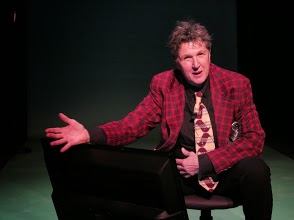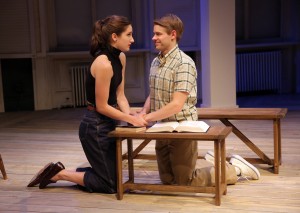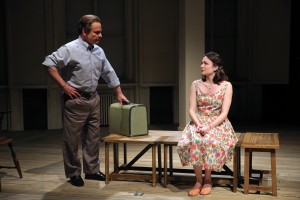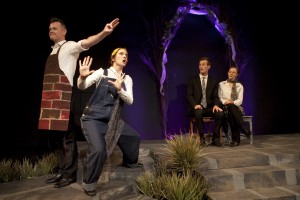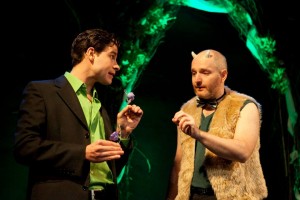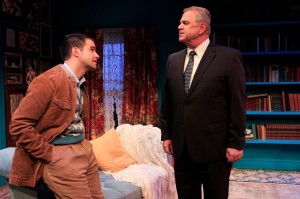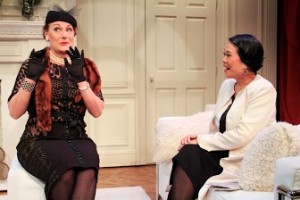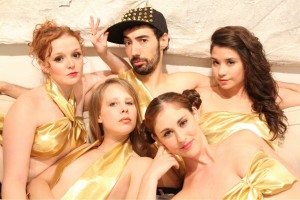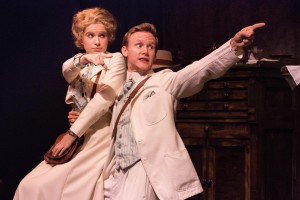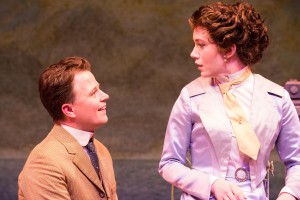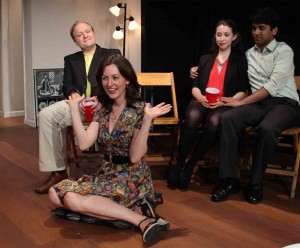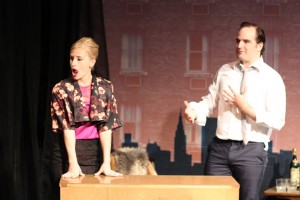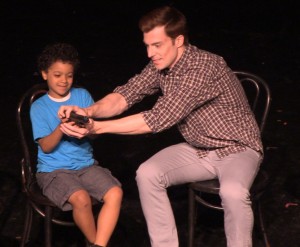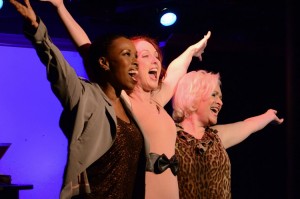Nostalgia is a powerful thing — it connects us all to a collective memory, reminding us constantly of better days when we were, perhaps, our better selves. In the midst of the 2010s, when everything from our fashion to our music to even our social media outlets (hello, instagram) derives inspiration from a previous era in one way or another, it is interesting to note the ways in which we are exploring our past. The Mad Ones — which has made its mission to "investigate cultural memory and nostalgia" — are doing just that in their latest outing, The Essential Straight and Narrow, currently playing at the New Ohio Theatre (154 Christopher Street, Ste. 1E).
The play starts when we meet a woman named Jo (Stephanie Wright Thompson) on the set of what looks like a motel room. It is presumably the 1970s, and the movie script she is privately rehearsing is also presumably a cheesy 1970s cop drama. There is a record player in the corner and a bedspread in off-colors: shades of mustard yellow and burnt sienna, just in case you had any doubt when this play took place. The opening scenes start out with Jo practicing a phone conversation and immediately pull you in with humor as Thompson pulls practically every slapstick move known to man while managing to ground it in reality. A hard thing to pull off, and something Thompson does throughout the play with ease and grace. It is this very skill that endears the audience to her, which is important as we start delving in and out of her character's memory. Moments later, the scene with Jo at the telephone "dissolves" — theatrically, of course — into a memory, in a motel room not unlike the one she is playacting in just moments before.
Here, other characters emerge: there's the charming Miss Debbie (Marc Bovino), a transgender woman Jo befriends; Paul (Michael Dalto), the quiet guitarist to Jo's former music ensemble; and Gram (Joe Curnutte), the gruff and standoffish vocalist. With each recurring flashback, we see snapshots of the group's time together in the motel room: a friendly bout of "The $10,000 Pyramid," a Dia de los Muertos-themed arts and crafts session, a country-folk-rock rehearsal, a crazy Halloween party soundtracked by James Brown and local urban legends are just some of the antics they get up to over the course of the night. With Laura Jellinek's set design, as well as Mike Inwood's lighting, we completely become immersed in these scenes, however brief they may be. (Also noteworthy are Asta Hostetter's costumes, which also delight in the weird and wonderful fashions of the '70s. I mean, flared jeans with cowboy boots, anyone?)
Adding to the immersion are the actors themselves, displaying a natural rapport and believable ease in their exchanges, creating a voyeuristic feel to each scene. In their respective roles as Paul and Gram, both Dalto and Curnette provide more-than-sufficient support to Thompson, complementing her often self-conscious Jo with their characters' quiet self-awareness. As the vivacious Miss Debbie, Bovino steals more than a few scenes, not only leaving the party-goers in his thrall, but the audience, as well. Rounding out the cast is an equally scene-stealing ensemble; in particular, Blake DeLong as Barrett, a headdress-donning party crasher who not only steals scenes, but also booze, and — of course — "the new James Brown!"
Despite its title, the play isn't a "straight-shooter" — when it comes to dispensing information, instead opting to leave it up to the audience to come to their own conclusions. What this critic has come to conclude is that The Essential Straight and Arrow is less an examination and more an ode to our past selves and what we once hoped and dreamt. Just as Jo's past struggle as a musician is reflected in her "current" struggle as an actress, perhaps what we can glean from the play is the idea that we must look back to our past in order to journey on into the future. The road ahead might not be a straight shot into success, but perhaps it's the getting there that's worth looking forward to.
The Essential Straight and Arrow ran at The New Ohio Theatre (154 Christopher Street, Ste. 1E, between Greenwich and Washington Streets) in New York City until June 14. For more information, visit www.NewOhioTheatre.org.





















